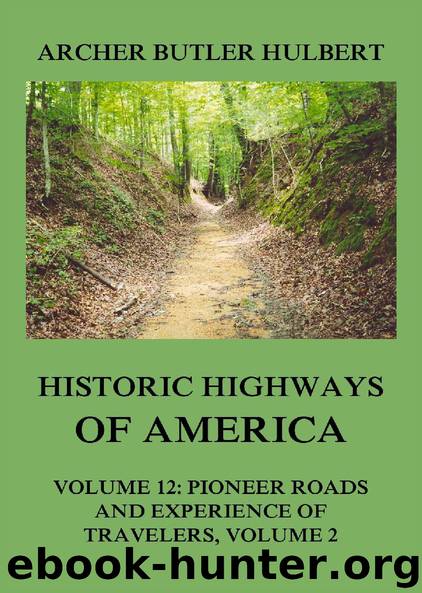Historic Highways of America: Volume 12: Pioneer Roads and Experiences of Travelers (II) by Archer Butler Hulbert

Author:Archer Butler Hulbert [Hulbert, Archer Butler]
Language: eng
Format: epub
Tags: Geschichte
Publisher: Jazzybee Verlag
Published: 2018-05-01T22:00:00+00:00
Each horse additional
.03
Cart, one horse
.06
Coach, or four wheeled carriage, two horses
.25
Each horse additional
.03
Carriage, one horse
.12½
Each horse additional
.06
Cart, two oxen
.08
Each yoke additional
.03
Saddle or led horse
.04
Sled, between December 15 and March 15
.12½
Score of cattle
.06
Score of sheep or hogs
.03
The old Genesee Road passed through as romantic and beautiful a land as heart could wish to see or know; but the road itself was a creation of comparatively modern days, in which Seneca and Mohawk were eliminated factors in the problem. Here, near this road, a great experiment was made a few years after its building, when a canal was proposed and dug, amid fears and doubts on the part of many, from Albany to Buffalo. One of the first persons to advocate a water highway which would eclipse the land route, sent a number of articles on the subject to a local paper, whose editor was compelled to refuse to print more of them, because of the ridicule to which they exposed the paper! Poor as the old road was in bad weather, people could not conceive of any better substitute.
When the Erie Canal was being built, so poor were the roads leading into the region traversed by the canal, that contractors were compelled to do most of their hauling in winter, when the ground was frozen and sleds could be used on the snow. Among the reasons given—as we shall see in a later monograph of this series—for delays in completing portions of the canal, was that of bad roads and the impossibility of sending heavy freight into the interior except in winter; and a lack of snow, during at least one winter, seriously handicapped the contractors. But when the Erie Canal was built, the prophecies of its advocates were fulfilled, as the rate per hundred-weight by canal was only one-tenth the rate charged by teamsters on the Genesee Road. The old “waggoners” who, for a generation, had successfully competed with the Inland Lock Navigation Company, could not compete with the Erie Canal, and it was indeed very significant that, when Governor Clinton and party made that first triumphal journey by canal-boat from Buffalo to Albany and New York—carrying a keg of Lake Erie water to be emptied into the Atlantic Ocean—they were not joyously received at certain points, such as Schenectady, where the old methods of transportation were the principal means of livelihood for a large body of citizens. How delighted were the old tavern-keepers in central New York with the opening of the Erie Canal, on whose boats immigrants ate and slept? About as happy, we may say, as were the canal operators when a railway was built, hurrying travelers on at such a rapid pace that their destinations could be reached, in many cases, between meals!
Yet until the railway came, the fast mail-stages rolled along over the Genesee Road, keeping alive the old traditions and the old breed of horses. Local business was vastly increased by the dawning of the new era; society adapted itself to new and altered
Download
This site does not store any files on its server. We only index and link to content provided by other sites. Please contact the content providers to delete copyright contents if any and email us, we'll remove relevant links or contents immediately.
| Automotive | Aviation |
| History | Mass Transit |
| Owner's Manuals & Maintenance Guides | Railroads |
| Reference | Ships |
Small Unmanned Fixed-wing Aircraft Design by Andrew J. Keane Andras Sobester James P. Scanlan & András Sóbester & James P. Scanlan(32743)
Navigation and Map Reading by K Andrew(5111)
Endurance: Shackleton's Incredible Voyage by Alfred Lansing(4676)
And the Band Played On by Randy Shilts(2129)
Wild Ride by Adam Lashinsky(1933)
The Box by Marc Levinson(1931)
Top 10 Prague (EYEWITNESS TOP 10 TRAVEL GUIDES) by DK(1930)
The Race for Hitler's X-Planes: Britain's 1945 Mission to Capture Secret Luftwaffe Technology by John Christopher(1817)
The One Percenter Encyclopedia by Bill Hayes(1787)
Trans-Siberian Railway by Lonely Planet(1703)
Girls Auto Clinic Glove Box Guide by Patrice Banks(1684)
Bligh by Rob Mundle(1653)
Looking for a Ship by John McPhee(1630)
Batavia's Graveyard by Mike Dash(1607)
Good with Words by Patrick Barry(1602)
TWA 800 by Jack Cashill(1592)
Fighting Hitler's Jets: The Extraordinary Story of the American Airmen Who Beat the Luftwaffe and Defeated Nazi Germany by Robert F. Dorr(1591)
Troubleshooting and Repair of Diesel Engines by Paul Dempsey(1557)
Ticket to Ride by Tom Chesshyre(1543)
